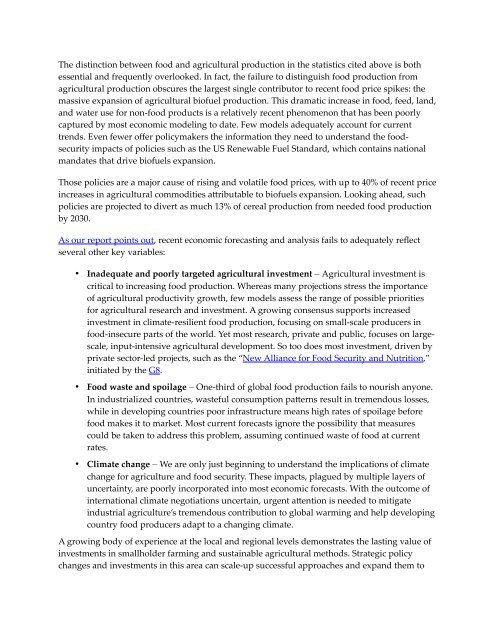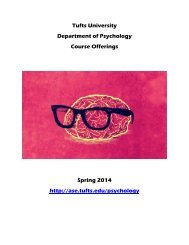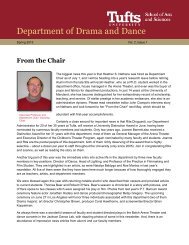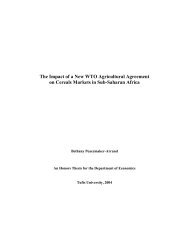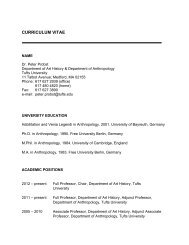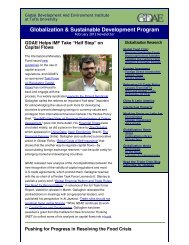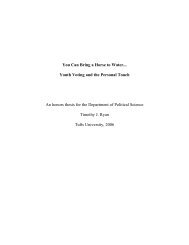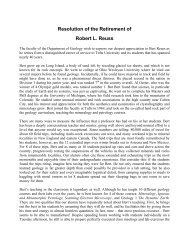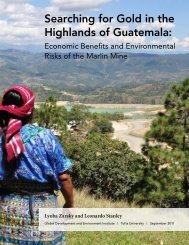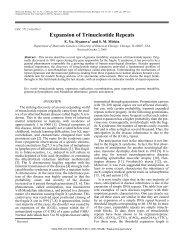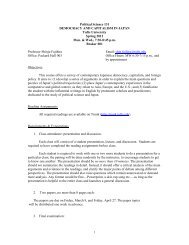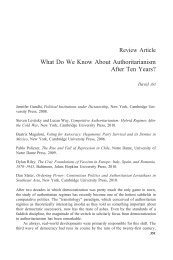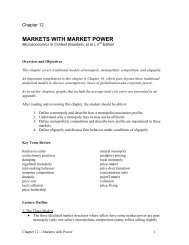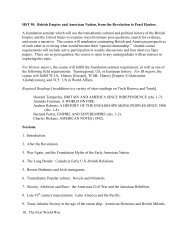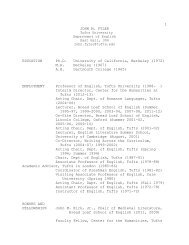Changing Course to Feed the World in 2050 - Tufts University
Changing Course to Feed the World in 2050 - Tufts University
Changing Course to Feed the World in 2050 - Tufts University
You also want an ePaper? Increase the reach of your titles
YUMPU automatically turns print PDFs into web optimized ePapers that Google loves.
The dist<strong>in</strong>ction between food and agricultural production <strong>in</strong> <strong>the</strong> statistics cited above is both<br />
essential and frequently overlooked. In fact, <strong>the</strong> failure <strong>to</strong> dist<strong>in</strong>guish food production from<br />
agricultural production obscures <strong>the</strong> largest s<strong>in</strong>gle contribu<strong>to</strong>r <strong>to</strong> recent food price spikes: <strong>the</strong><br />
massive expansion of agricultural biofuel production. This dramatic <strong>in</strong>crease <strong>in</strong> food, feed, land,<br />
and water use for non-food products is a relatively recent phenomenon that has been poorly<br />
captured by most economic model<strong>in</strong>g <strong>to</strong> date. Few models adequately account for current<br />
trends. Even fewer offer policymakers <strong>the</strong> <strong>in</strong>formation <strong>the</strong>y need <strong>to</strong> understand <strong>the</strong> foodsecurity<br />
impacts of policies such as <strong>the</strong> US Renewable Fuel Standard, which conta<strong>in</strong>s national<br />
mandates that drive biofuels expansion.<br />
Those policies are a major cause of ris<strong>in</strong>g and volatile food prices, with up <strong>to</strong> 40% of recent price<br />
<strong>in</strong>creases <strong>in</strong> agricultural commodities attributable <strong>to</strong> biofuels expansion. Look<strong>in</strong>g ahead, such<br />
policies are projected <strong>to</strong> divert as much 13% of cereal production from needed food production<br />
by 2030.<br />
As our report po<strong>in</strong>ts out, recent economic forecast<strong>in</strong>g and analysis fails <strong>to</strong> adequately reflect<br />
several o<strong>the</strong>r key variables:<br />
• Inadequate and poorly targeted agricultural <strong>in</strong>vestment – Agricultural <strong>in</strong>vestment is<br />
critical <strong>to</strong> <strong>in</strong>creas<strong>in</strong>g food production. Whereas many projections stress <strong>the</strong> importance<br />
of agricultural productivity growth, few models assess <strong>the</strong> range of possible priorities<br />
for agricultural research and <strong>in</strong>vestment. A grow<strong>in</strong>g consensus supports <strong>in</strong>creased<br />
<strong>in</strong>vestment <strong>in</strong> climate-resilient food production, focus<strong>in</strong>g on small-scale producers <strong>in</strong><br />
food-<strong>in</strong>secure parts of <strong>the</strong> world. Yet most research, private and public, focuses on largescale,<br />
<strong>in</strong>put-<strong>in</strong>tensive agricultural development. So <strong>to</strong>o does most <strong>in</strong>vestment, driven by<br />
private sec<strong>to</strong>r-led projects, such as <strong>the</strong> “New Alliance for Food Security and Nutrition,”<br />
<strong>in</strong>itiated by <strong>the</strong> G8.<br />
• Food waste and spoilage – One-third of global food production fails <strong>to</strong> nourish anyone.<br />
In <strong>in</strong>dustrialized countries, wasteful consumption patterns result <strong>in</strong> tremendous losses,<br />
while <strong>in</strong> develop<strong>in</strong>g countries poor <strong>in</strong>frastructure means high rates of spoilage before<br />
food makes it <strong>to</strong> market. Most current forecasts ignore <strong>the</strong> possibility that measures<br />
could be taken <strong>to</strong> address this problem, assum<strong>in</strong>g cont<strong>in</strong>ued waste of food at current<br />
rates.<br />
• Climate change – We are only just beg<strong>in</strong>n<strong>in</strong>g <strong>to</strong> understand <strong>the</strong> implications of climate<br />
change for agriculture and food security. These impacts, plagued by multiple layers of<br />
uncerta<strong>in</strong>ty, are poorly <strong>in</strong>corporated <strong>in</strong><strong>to</strong> most economic forecasts. With <strong>the</strong> outcome of<br />
<strong>in</strong>ternational climate negotiations uncerta<strong>in</strong>, urgent attention is needed <strong>to</strong> mitigate<br />
<strong>in</strong>dustrial agriculture’s tremendous contribution <strong>to</strong> global warm<strong>in</strong>g and help develop<strong>in</strong>g<br />
country food producers adapt <strong>to</strong> a chang<strong>in</strong>g climate.<br />
A grow<strong>in</strong>g body of experience at <strong>the</strong> local and regional levels demonstrates <strong>the</strong> last<strong>in</strong>g value of<br />
<strong>in</strong>vestments <strong>in</strong> smallholder farm<strong>in</strong>g and susta<strong>in</strong>able agricultural methods. Strategic policy<br />
changes and <strong>in</strong>vestments <strong>in</strong> this area can scale-up successful approaches and expand <strong>the</strong>m <strong>to</strong>


